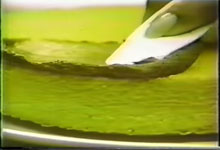2. Flakes
- See also ARF: Notes & Comments.
(Take it away, Bob . . . )
Adrian Belew, interviewed by Gary Marks, T'Mershi Duween, August, 1994
The one I remember was "Flakes." When Frank showed it to me at home one night on a weekend, when he sat and played it on guitar, it sounded like a lousy folk song (laughs), so I started kidding about with it, singing it like Bob Dylan, and he said "That's in the show.You're going to do it that way."
Adrian Belew, interviewed by Richard Abowitz, "The Universe Of Frank Zappa," Gadfly, May, 1999
I went home with Frank, and he was showing me an upcoming song called "Flakes." Now, a little known fact about Frank is that he really couldn't play and sing at the same time. One of the reasons he hired me, he told me, was because he liked the fact that I sang and played together so well. On a lot of the music, I would double what Frank was doing. I'd double his vocals for him exactly, or I'd be doubling his guitar parts so he could be free to do either one. When he played "Flakes" for me, he also had to sing it. It was kind of unusual. It sounded so bad it sounded like him doing a Bob Dylan impression to me. It sounded like a folk song, which it was anything but. So jokingly I started singing along with it in a Bob Dylan imitation, and he said, "That's it, that's in the show, you're gonna be doing that."
Adrian Belew, Guitarhoo!, April 16, 2004
Um, there were a few times when I was in Franks company over the weekends that I would affect his thoughts on something. One time in particular I remember he was playing the song which would become "Flakes". He was singing this sort of folk song part in the middle. And when Frank sang and played he couldn't do that really. So when he sang and played guitar he couldn't do that at the same time. He had a real hard time to do that. It sounded like a bad Bob Dylan. hahaha... So I started singing it like a bad Bob Dylan immitation and it stuck and that became part of that song.
Adrian Belew, "Anecdote #464 Scene One," Elephant Blog, May 14, 2007
Flakes.
it begins in late 1977 in the basement of frank zappa's hollywood home. it's a saturday and as usual I'm learning the material for next week's rehearsals. being the only "non-reader" in the band this was a common way for me to prepare. today's lesson is a brand new song frank has just written called flakes.
frank did not play guitar and sing at the same time. if you watch footage of his concerts he's either playing the guitar or singing, never both. I found out why. he quietly played and sang the middle section of the song for me. it sounded terrible. like a bad folk song. I started making fun of him by singing it in a bob dylan voice; "I asked as nice as I coouuld".
"that's it," said frank, "that's in the show."
and that is how I ended up doing a bob dylan imitation on a frank zappa record.
I always wondered what bob dylan might think of it.
Adrian Belew, interviewed by Matthew Shapiro, State Of Mind Music, November 1, 2008
How did that whole Dylan impersonation come about?
Yeah‚ there's an interesting story behind that one. Like I said‚ we rehearsed all week for three months‚ and on the weekends I would usually go home with Frank and he would show me what was coming up the next week. And that's how I could learn what he wrote. So‚ he was showing a new song he was writing‚ "Flakes‚" and a lot of people don't know this about Frank‚ but he couldn't really play and sing at the same time. If you ever watch him you'll notice that. So‚ I found out why with this song. He played it for me and he sounded like a bad folk singer. [laughter] I just started singing it like Bob Dylan‚ and he thought that was great and wanted to put that in the song. It really just came about because Frank sounded like a bad folk singer. [laughs]
Arthur Barrow, Of Course I Said Yes!, 2016, p. 62-63
To my knowledge, [FZ] never played guitar and sang at the same time. He claimed to be incapable of it, which I found hard to believe, but that's what he said. I sure never saw him do it.
FZ, interviewed by Headley Gritter, Music Pulse, July, 1980
As for Dylan, I've never met him, I've never talked to him. Some of his earlier records I've enjoyed, but I don't really know his recent material.
She's frosting a cake
With a paper knife
cyranoDB, Zappateers, August 1, 2016
"Frosting a cake with a paper knife", is from a frosting commercial, they don't actually say it rather show a woman doing it.
Brad Henserling, Zappateers, August 1, 2016
